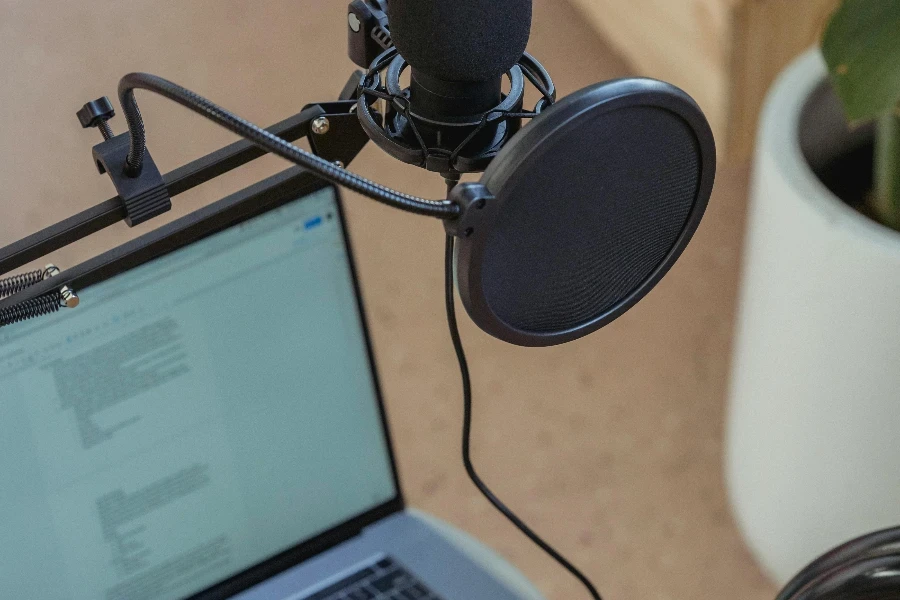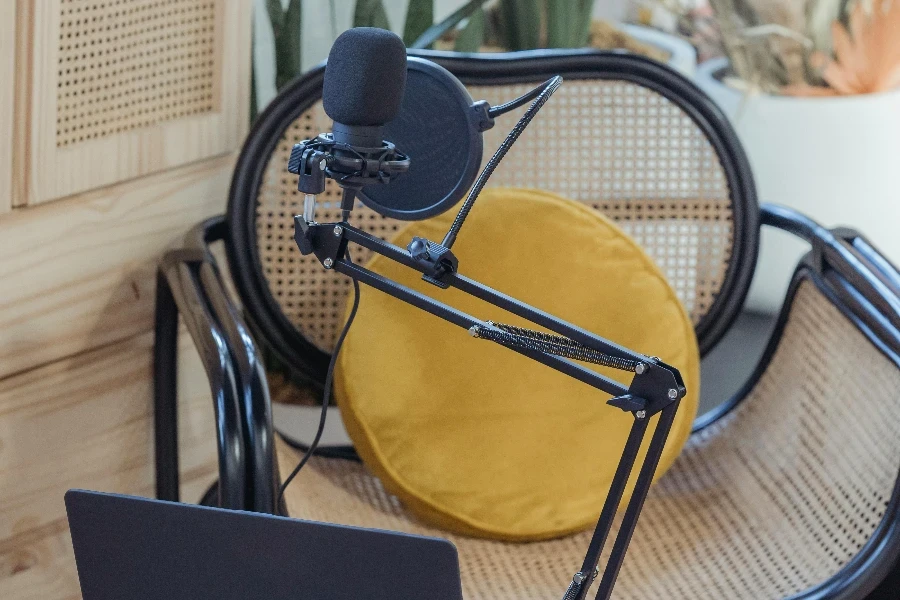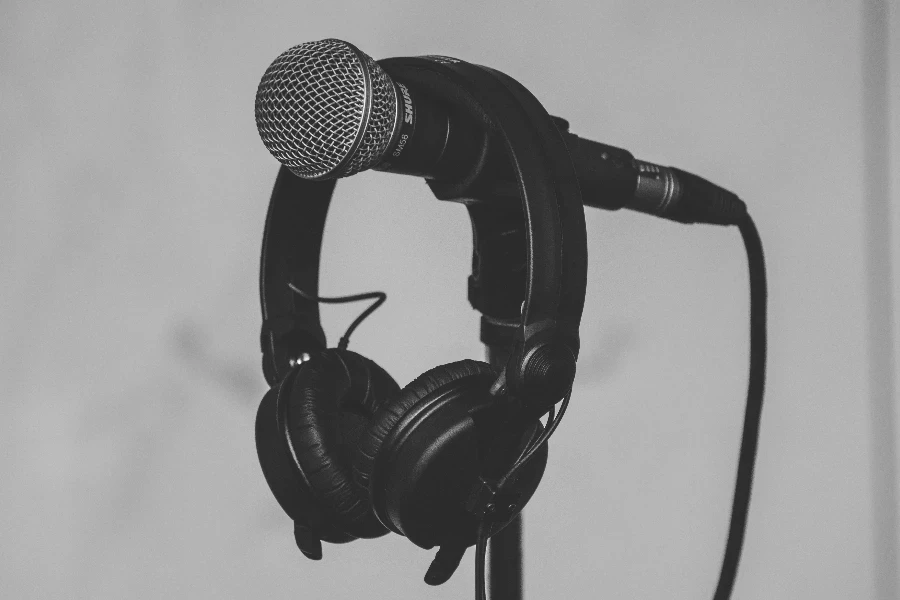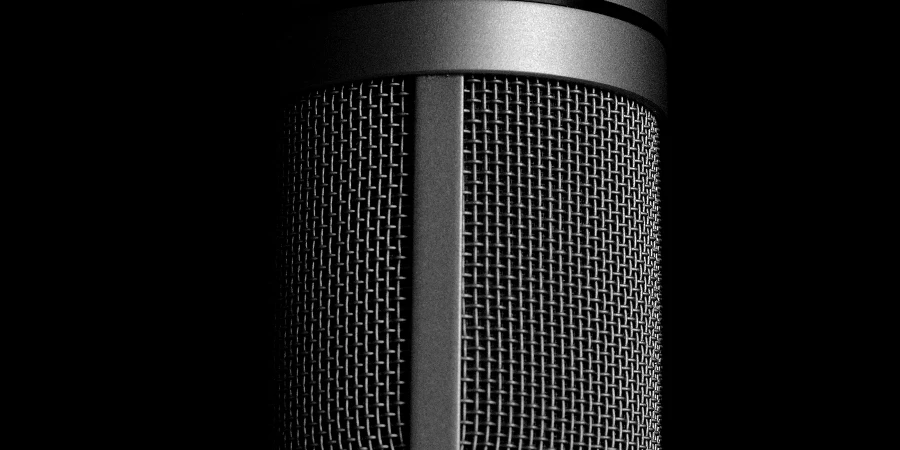The studio microphone market continues to evolve rapidly in 2025, driven by advancements in technology and the growing number of content creators. This article provides an in-depth analysis of the essentials of studio microphones, including key features, market trends, and top brands. Professional buyers will find valuable insights to make informed purchasing decisions in this competitive landscape.
Table of Contents:
– Understanding the Current Demand for Studio Microphones
– Analyzing the Competitive Landscape
– Key Features to Consider When Choosing Studio Microphones
– Types of Studio Microphones: Pros and Cons
– Essential Accessories for Studio Microphones
– Wrapping Up
Understanding the Current Demand for Studio Microphones

Key Market Statistics
The global microphone market has shown significant growth, expanding from USD 2.79 billion in 2023 to USD 2.97 billion in 2024. This market is projected to continue its upward trajectory, reaching USD 4.48 billion by 2030, with a compound annual growth rate (CAGR) of 6.99%. The increasing adoption of smartphones and portable electronics, advancements in voice recognition software, and the rising popularity of video content creation are key drivers of this growth. The market for studio microphones, a subset of the broader microphone market, is also experiencing robust demand due to these factors.
In 2024, the global market for wireless microphones alone is estimated at USD 2.04 billion, growing at a CAGR of 7.4%. This growth is driven by the proliferation of consumer electronics and the media and entertainment sector. The demand for high-quality audio equipment, including studio microphones, is further bolstered by the increasing number of content creators and the rise of home studios. The market for MEMS microphones, which are integral to many modern studio microphones, is expected to grow from USD 2.26 billion in 2024 to USD 3.07 billion by 2029, at a CAGR of 6.32%.
Popular Applications and Usage Trends
Studio microphones are essential in various applications, including music production, podcasting, broadcasting, and live performances. The rise of home studios and the increasing number of independent content creators have significantly boosted the demand for studio microphones. In the United States alone, the number of home studios has increased by 20% over the past five years, driven by the affordability and accessibility of high-quality recording equipment.
The integration of advanced technologies such as 3D audio and beamforming is creating new opportunities for studio microphones. These technologies enhance the audio experience by providing immersive sound and selective reception of signals from specific directions. The use of studio microphones in podcasting has also surged, with the number of active podcasts growing from 850,000 in 2023 to over 1 million in 2024. This trend is expected to continue, driven by the increasing popularity of podcasts as a medium for content consumption.
Analyzing the Competitive Landscape

Major Players in the Market
The studio microphone market is dominated by several key players, including Shure Incorporated, Sennheiser electronic GmbH & Co. KG, Audio-Technica Corporation, and Rode Microphones. Shure, known for its high-quality microphones, holds a significant market share due to its extensive product range and strong brand reputation. Sennheiser, another major player, is renowned for its innovative audio solutions and has a strong presence in both the professional and consumer markets.
Audio-Technica and Rode Microphones are also prominent in the studio microphone market. Audio-Technica’s microphones are widely used in professional studios and live performances, while Rode Microphones is known for its high-quality, affordable products that cater to both professional and amateur users. These companies continuously invest in research and development to introduce new products and maintain their competitive edge. For instance, Rode’s recent launch of the Wireless PRO, a compact dual-channel wireless microphone system, highlights the company’s commitment to innovation.
Emerging Brands and Innovations
Emerging brands such as LEWITT GmbH and Aston Microphones are making significant strides in the studio microphone market. LEWITT, known for its high-performance microphones, has gained a reputation for its innovative designs and superior sound quality. Aston Microphones, with its unique approach to microphone design and manufacturing, has quickly become a favorite among professional audio engineers and musicians.
Innovations in microphone technology are also driving market growth. The development of MEMS microphones, which offer high performance in a compact form factor, is a notable trend. These microphones are increasingly used in studio settings due to their ability to deliver high-quality audio with minimal distortion. Additionally, the integration of artificial intelligence (AI) for automatic gain control and voice recognition is enhancing the functionality and usability of studio microphones. Companies are also focusing on sustainability, with several brands introducing eco-friendly materials and manufacturing processes to meet the growing demand for environmentally responsible products.
Key Features to Consider When Choosing Studio Microphones

Frequency Response
Frequency response is a critical feature to consider when selecting a studio microphone. It refers to the range of frequencies a microphone can capture, typically measured in Hertz (Hz). A flat frequency response is ideal for capturing a natural and accurate sound, while tailored responses can enhance specific frequencies for particular applications. For instance, a microphone with a boosted high-frequency response might be better suited for capturing vocals, adding clarity and presence to the recording.
Different microphones offer varying frequency responses, making them suitable for different recording scenarios. For example, a microphone with a wide frequency response range, such as 20 Hz to 20 kHz, can capture the full spectrum of human hearing, making it versatile for various instruments and vocals. On the other hand, a microphone with a narrower frequency response might be more specialized, such as a kick drum mic that emphasizes low frequencies. Understanding the frequency response of a microphone helps in choosing the right tool for the desired recording outcome.
Polar Patterns
Polar patterns describe the directional sensitivity of a microphone, indicating how it picks up sound from different angles. The most common polar patterns are cardioid, omnidirectional, and figure-8. Cardioid microphones capture sound primarily from the front, making them ideal for isolating a single sound source in a noisy environment. This pattern is commonly used for vocals and solo instruments, providing good rejection of off-axis sounds.
Omnidirectional microphones, on the other hand, capture sound equally from all directions. This makes them suitable for recording ambient sounds or group performances where capturing the room’s acoustics is essential. Figure-8 microphones pick up sound from the front and back while rejecting sounds from the sides, making them useful for stereo recording techniques or capturing two sound sources simultaneously. Understanding polar patterns is crucial for selecting the right microphone for specific recording situations.
Sensitivity and SPL Handling
Sensitivity and Sound Pressure Level (SPL) handling are important technical specifications to consider when choosing a studio microphone. Sensitivity measures how effectively a microphone converts acoustic sound into an electrical signal, typically expressed in millivolts per Pascal (mV/Pa). A higher sensitivity microphone will produce a stronger output signal, which can be beneficial for capturing quiet sound sources without requiring excessive gain.
SPL handling indicates the maximum sound pressure level a microphone can handle before distorting, measured in decibels (dB). For instance, a microphone with an SPL handling of 140 dB can capture very loud sounds, such as drums or amplified instruments, without distortion. Choosing a microphone with appropriate sensitivity and SPL handling ensures that it can accurately capture the intended sound source without unwanted noise or distortion.
Connectivity Options
Connectivity options are a crucial consideration when selecting a studio microphone, as they determine how the microphone interfaces with other recording equipment. The two primary types of connections are XLR and USB. XLR microphones are the industry standard for professional audio recording, offering balanced connections that reduce noise and interference. They require an audio interface or mixer with XLR inputs, providing greater flexibility and control over the recording process.
USB microphones, on the other hand, are designed for direct connection to computers, making them convenient for home studios and podcasting. They typically include built-in preamps and analog-to-digital converters, simplifying the setup process. However, they may offer less flexibility compared to XLR microphones. Understanding the connectivity options helps in choosing a microphone that integrates seamlessly with the existing recording setup.
Build Quality and Durability
Build quality and durability are essential factors to consider when investing in a studio microphone. High-quality materials and construction ensure that the microphone can withstand the rigors of regular use and maintain consistent performance over time. For instance, microphones with metal housings and robust internal components are more likely to endure physical impacts and environmental factors.
Durability is particularly important for microphones used in live sound or mobile recording setups, where they may be subjected to frequent handling and transportation. Additionally, features such as shock mounts and protective grilles can enhance a microphone’s durability by minimizing the impact of vibrations and accidental drops. Investing in a well-built microphone ensures long-term reliability and consistent audio quality.
Types of Studio Microphones: Pros and Cons

Dynamic Microphones
Dynamic microphones are known for their durability and versatility, making them a popular choice for various recording applications. They operate using a diaphragm attached to a coil of wire, which moves within a magnetic field to generate an electrical signal. This design makes them less sensitive to high sound pressure levels, making them ideal for capturing loud sound sources like drums and guitar amplifiers.
One of the main advantages of dynamic microphones is their robustness and ability to handle rough handling and extreme conditions. They do not require external power, making them convenient for live performances and field recordings. However, dynamic microphones typically have a limited frequency response and lower sensitivity compared to condenser microphones, which can result in less detailed and nuanced recordings. Despite this, their affordability and reliability make them a staple in many recording studios.
Condenser Microphones
Condenser microphones are highly regarded for their sensitivity and accuracy, making them a preferred choice for studio recordings. They operate using a diaphragm placed close to a backplate, creating a capacitor that changes capacitance with sound pressure variations. This design allows them to capture a wide frequency range and subtle details, making them ideal for vocals, acoustic instruments, and studio applications.
One of the main advantages of condenser microphones is their ability to capture high-fidelity audio with excellent transient response. They require external power, usually provided by phantom power from an audio interface or mixer. However, condenser microphones are more delicate and sensitive to environmental conditions, making them less suitable for high-SPL sources or rough handling. Their higher cost and need for careful placement and handling are trade-offs for their superior audio quality.
Ribbon Microphones
Ribbon microphones are prized for their smooth and natural sound, often described as warm and vintage. They use a thin metal ribbon suspended in a magnetic field to generate an electrical signal. This design allows them to capture sound with a figure-8 polar pattern, making them ideal for recording vocals, strings, and brass instruments with a rich and detailed sound.
One of the main advantages of ribbon microphones is their ability to capture high-frequency detail without harshness, providing a smooth and natural sound. However, they are more fragile than dynamic and condenser microphones, requiring careful handling and protection from high-SPL sources. Ribbon microphones also typically have lower output levels, necessitating high-gain preamps. Despite these limitations, their unique sound quality makes them a valuable tool in many recording studios.
USB vs. XLR Microphones
USB microphones offer convenience and ease of use, making them popular for home studios, podcasting, and content creation. They integrate a preamp and analog-to-digital converter, allowing direct connection to a computer via USB. This plug-and-play functionality simplifies the recording process, making them accessible to beginners and those with limited technical knowledge.
However, USB microphones may offer less flexibility and lower audio quality compared to XLR microphones. XLR microphones, on the other hand, are the standard for professional audio recording, providing balanced connections that reduce noise and interference. They require an audio interface or mixer, offering greater control over gain, signal routing, and processing. While XLR microphones involve a more complex setup, they provide superior audio quality and versatility, making them the preferred choice for professional studios.
Essential Accessories for Studio Microphones

Pop Filters and Windscreens
Pop filters and windscreens are essential accessories for improving the quality of vocal recordings. Pop filters are typically placed between the microphone and the vocalist to reduce plosive sounds, which are caused by bursts of air hitting the microphone diaphragm. These sounds, often produced by consonants like “p” and “b,” can cause distortion and unwanted noise in recordings. Pop filters are usually made of a thin mesh material that diffuses the air before it reaches the microphone.
Windscreens, on the other hand, are foam covers placed over the microphone to reduce wind noise and breath sounds. They are particularly useful for outdoor recordings or situations where the microphone is exposed to moving air. Windscreens also provide a layer of protection for the microphone diaphragm, helping to extend its lifespan. Both pop filters and windscreens are inexpensive yet effective tools for enhancing vocal clarity and reducing unwanted noise.
Shock Mounts
Shock mounts are crucial for isolating microphones from mechanical vibrations and handling noise. They work by suspending the microphone in a cradle, typically using elastic bands or other flexible materials, which absorb vibrations before they reach the microphone. This isolation is particularly important in studio environments where even minor vibrations from footsteps, equipment, or environmental factors can be picked up by sensitive microphones.
Using a shock mount helps to ensure that the recorded audio is clean and free from unwanted low-frequency rumble or handling noise. They are especially beneficial for condenser microphones, which are more sensitive to vibrations. Investing in a quality shock mount can significantly improve the overall sound quality of recordings by minimizing the impact of external vibrations.
Mic Stands and Boom Arms
Mic stands and boom arms are essential for positioning microphones accurately and securely. A sturdy mic stand provides a stable base for the microphone, allowing for precise placement and adjustment. Boom arms extend the reach of the mic stand, enabling flexible positioning for various recording scenarios, such as overhead drum miking or capturing vocals from different angles.
When choosing a mic stand or boom arm, consider factors such as height adjustability, stability, and ease of use. Heavy-duty stands with weighted bases or tripod designs offer greater stability, reducing the risk of tipping over. Boom arms with adjustable angles and lengths provide versatility for different recording setups. Investing in high-quality mic stands and boom arms ensures reliable and flexible microphone placement, contributing to better recording results.
Audio Interfaces and Preamps
Audio interfaces and preamps are essential components for connecting microphones to recording systems and enhancing audio quality. An audio interface converts analog signals from microphones into digital signals that can be processed by a computer. It typically includes preamps, which amplify the microphone signal to a usable level. High-quality preamps are crucial for maintaining the integrity of the audio signal, providing clean gain without adding noise or distortion.
When selecting an audio interface, consider factors such as the number of inputs and outputs, preamp quality, and connectivity options. Interfaces with multiple inputs allow for simultaneous recording of multiple microphones, while high-quality preamps ensure accurate and transparent amplification. Additional features like phantom power, direct monitoring, and low-latency performance enhance the recording experience. Investing in a reliable audio interface and preamp is essential for achieving professional-quality recordings.
Wrapping Up
Choosing the right studio microphone and accessories is crucial for achieving high-quality recordings. By understanding key features such as frequency response, polar patterns, and connectivity options, you can make informed decisions that enhance your recording setup.





 Afrikaans
Afrikaans አማርኛ
አማርኛ العربية
العربية বাংলা
বাংলা Nederlands
Nederlands English
English Français
Français Deutsch
Deutsch हिन्दी
हिन्दी Bahasa Indonesia
Bahasa Indonesia Italiano
Italiano 日本語
日本語 한국어
한국어 Bahasa Melayu
Bahasa Melayu മലയാളം
മലയാളം پښتو
پښتو فارسی
فارسی Polski
Polski Português
Português Русский
Русский Español
Español Kiswahili
Kiswahili ไทย
ไทย Türkçe
Türkçe اردو
اردو Tiếng Việt
Tiếng Việt isiXhosa
isiXhosa Zulu
Zulu